We’ve all been there. Staring at a mountain of digital paperwork—invoices, insurance claims, patient records, you name it. It's the kind of repetitive work that slowly drains your soul and makes you wonder if you’re secretly living in a black-and-white movie from the 1950s. On the flip side, if you're in the AI space, you know the absolute grind of preparing high-quality training data. It’s the unglamorous, foundational work that makes or breaks a model.
For years, we've been promised that AI would swoop in and save us from this drudgery. And while some tools have come close, I recently stumbled upon a platform that feels a little different. It's called V7, and it's been making some noise in circles that care about serious AI implementation, not just chatbot novelties. It’s not just about automating a task; it's about automating entire, complex workflows and building custom AI brains that actually understand your specific business. Intrigued? I certainly was.
So, What Exactly is V7? Breaking It Down.
At first glance, V7 looks like another slick SaaS platform. But when you look under the hood, it's really two powerful engines in one chassis. Think of it less as a single tool and more as a comprehensive AI workshop for your business.
V7 Go: Your New AI-Powered Office Assistant
First up is V7 Go. This is the part that tackles that mountain of paperwork I mentioned. V7 calls it “knowledge work automation,” which is a fancy way of saying it gets documents processed without you having to lift a finger. It’s built for industries drowning in forms and reports—think finance, insurance, healthcare, and logistics. It uses AI agents to read, understand, and extract information from multi-modal documents. That means it can pull a client name from paragraph one, a total cost from a table on page two, and verify a signature from an image at teh bottom. All from the same document. It’s like giving your team a crew of hyper-efficient interns who work 24/7 and have a near-photographic memory.
V7 Darwin: The Data Labeling Powerhouse
Then there’s V7 Darwin. This is for the builders, the ML engineers, the data scientists. If you’re building any kind of computer vision or Generative AI model, you know the golden rule: garbage in, garbage out. The quality of your AI is directly tied to the quality of its training data. Darwin is a best-in-class tool designed to make this process less painful and way more accurate. It provides AI-assisted labeling tools that can seriously speed up the annotation process, whether you're labeling medical scans to detect anomalies or annotating video footage for autonomous vehicles. It’s about accelerating that crucial step from R&D to a real, production-ready model.
The Human and AI Collaboration Dance
Here’s what I think is the most interesting part of V7’s philosophy. It’s not about firing all your data entry clerks and letting the robots take over. It’s about creating a powerful partnership between humans and AI. Their whole system is built around this “human-in-the-loop” concept. The AI does the initial, heavy-lifting—categorizing 2,000 expense reports, for instance. But then, a human expert can quickly review, correct the edge cases, and give the final sign-off.
This does two things. First, it ensures accuracy, which is non-negotiable in regulated industries. Second, every correction a human makes teaches the AI. It gets smarter, more accurate, and more attuned to your specific data over time. You’re not just using a generic AI; you’re building a trustworthy AI that has learned from your best people. That’s a massive distinction.

Visit V7
This approach moves us beyond the simple, often brittle automation of the past and into a more resilient, intelligent system. It’s a bit like a master craftsman teaching an apprentice—the apprentice (AI) handles the bulk work, and the master (human) provides the finishing touches and critical judgment.
Key Features That Caught My Eye
Drilling down a bit, a few things really stand out. The no-code framework for LLMs is a big one. It means you don't need a team of PhDs to start building and deploying custom AI agents for your workflows. Your subject matter experts, the people who actually know the documents inside and out, can be involved in building the automation. This democratizes the whole process.
The multi-modal data extraction I mentioned earlier is also a game-changer. So many business processes involve documents with a mix of text, tables, images, and even handwritten notes. Most tools choke on that complexity. V7 is designed to handle it gracefully. And, of course, there’s the enterprise-grade security and compliance. For anyone in healthcare dealing with HIPAA or finance with its own alphabet soup of regulations, this is table stakes. Knowing that the platform is built with a security-first mindset provides some much-needed peace of mind.
Let's Talk About the Money: V7 Pricing
Alright, the big question. How much does this magic cost? If you go to their site, you won't find a simple three-tiered pricing page. V7 uses a custom pricing model, especially for its V7 Go product. The pricing is broken down into three components:
- Platform fee: Access to the core V7 platform and its features.
- User licenses: A per-seat cost for the members of your team who will be using it.
- Data processing charges: This is a usage-based component, likely tied to the volume of documents or data points you process.
Now, I know what some of you are thinking. “Ugh, I have to talk to a salesperson.” And yeah, I get it. I personally prefer transparent pricing. However, for a platform this specialized and enterprise-focused, it makes a certain kind of sense. The needs of a hospital processing 100,000 patient files a month are wildly different from a logistics company tracking 5,000 bills of lading. A custom quote allows the pricing to scale with your actual usage and complexity. This is definitely not a tool for a solo founder tinkering on a weekend, but for an established business, this model can be more cost-effective in the long run than a one-size-fits-all plan.
The Good, The Bad, and The Realistic
No tool is perfect, so let’s get real. Based on what I've seen and the information out there, here's my honest take.
On the plus side, the benefits are clear. You're looking at major productivity gains by automating tedious work. You’re getting access to tools that produce incredibly high-quality training data, leading to better, more reliable AI models. And the robust security is a massive win for any serious organization. The AI-assisted features feel less like a gimmick and more like a genuine force multiplier for your team.
On the other hand, there's an initial setup and configuration process. This isn’t a magical app you just download and run. You have to invest time in setting up your workflows and teaching the AI agents. Also, for truly complex or ambiguous cases, you’ll still need human intervention. The AI is an assistant, not a replacement for expertise. And the variable pricing, while logical, could be a barrier for smaller companies trying to budget precisely.
Who is V7 Actually For?
After spending some time with it, the ideal user profile for V7 becomes pretty clear. It's for medium-to-large enterprises in data-intensive industries that are ready to make a serious investment in AI. If your company’s core operations rely on processing vast amounts of complex documents, V7 Go could be a transformative investment.
If your company is building its own proprietary AI, especially in computer vision, V7 Darwin is a top-tier contender to be the backbone of your data operations. It’s for teams who have moved past the experimentation phase and need to build scalable, production-grade AI systems. It's for the organization that understands that a small percentage point increase in model accuracy can translate to millions in revenue or savings.
Final Thoughts
So, is V7 the secret weapon? For the right company, I honestly think it could be. It bridges the gap between the promise of AI and the practical reality of business operations. It’s a sophisticated, powerful platform that focuses on collaboration, customization, and trust—three pillars that are often missing in the AI hype cycle.
It’s not a simple, cheap solution. It requires commitment. But for businesses ready to move beyond off-the-shelf AI and build intelligent systems that create a real competitive advantage, V7 is absolutely a platform worth a very, very close look.
Frequently Asked Questions (FAQ)
- What's the main difference between V7 Go and V7 Darwin?
- Think of it this way: V7 Go is for using AI to automate business workflows, like processing documents. V7 Darwin is for building AI by helping you create the high-quality labeled training data that computer vision and GenAI models need.
- Is V7 a completely no-code platform?
- V7 features a powerful no-code framework that allows business users to build and manage AI workflows without writing code. However, the V7 Darwin side of the platform is a tool for technical users like data scientists and ML engineers, who will use the labeled data to code and train models.
- What kinds of data and documents can V7 handle?
- V7 is designed to be multi-modal, meaning it supports a wide variety of data types and file formats. This includes standard documents like PDFs and images (JPG, PNG), as well as more complex data like medical imagery (DICOM) and video files.
- How does V7's pricing actually work?
- V7 uses a custom pricing model based on your specific needs. The cost is a combination of a base platform fee, the number of user licenses you require, and usage-based charges for data processing. You'll need to contact their sales team for a custom quote.
- Can V7 Go recognize and extract handwritten text?
- Yes, according to their site, the platform has capabilities to recognize and process handwritten text, which is a critical feature for industries that still deal with manually filled forms, like healthcare and logistics.
- Is my data secure on the V7 platform?
- V7 emphasizes its enterprise-grade security. They offer solutions that are compliant with regulations like HIPAA and GDPR, making it a suitable choice for organizations that handle sensitive data.
Reference and Sources
- V7 Official Website - For product information, case studies, and contact details.
- TechCrunch Article on V7 Funding - Provides background on the company's growth and vision.
- The Importance of High-Quality Training Data - A Google AI Blog post discussing the principles behind building effective AI, which is core to V7 Darwin's mission.



